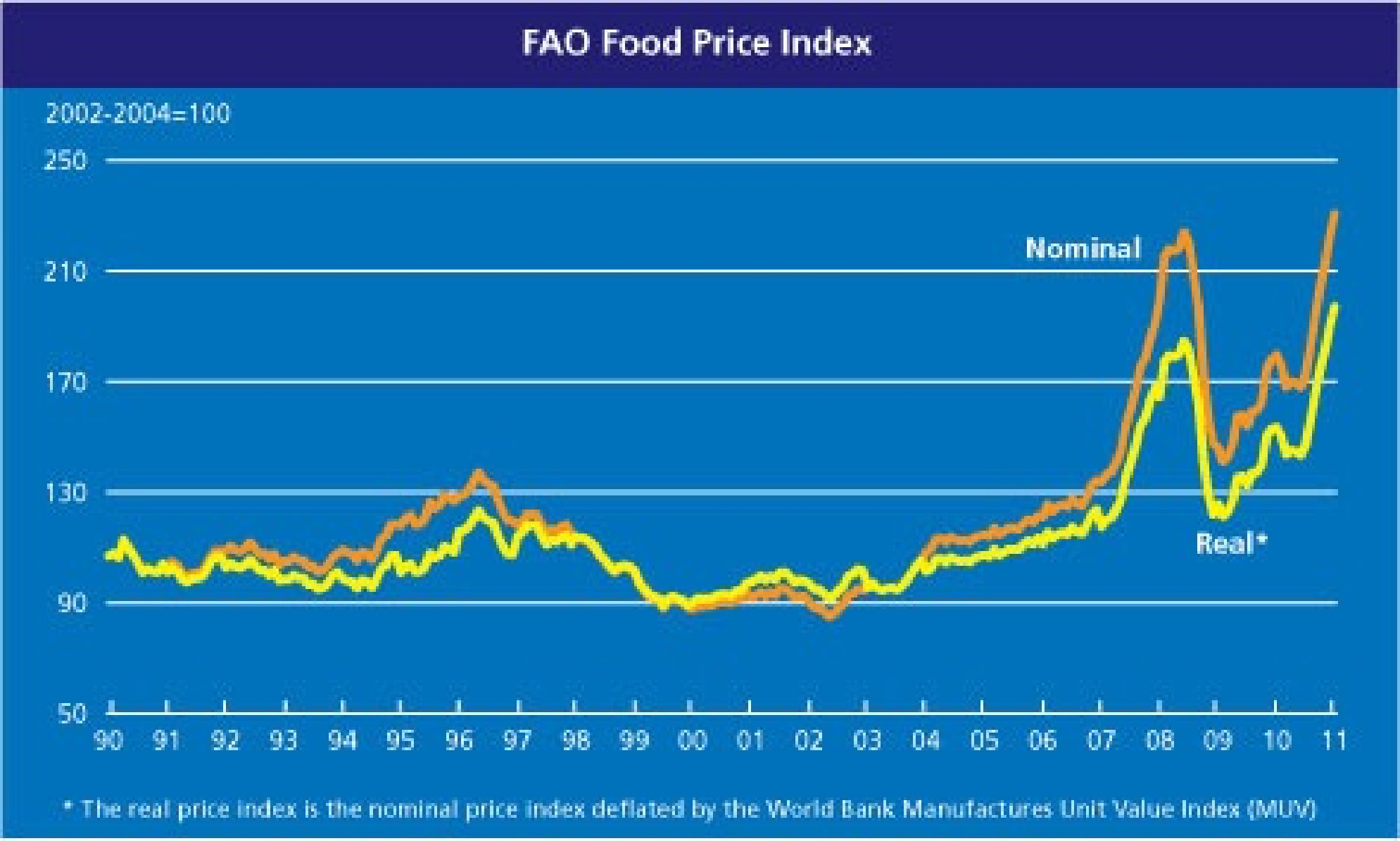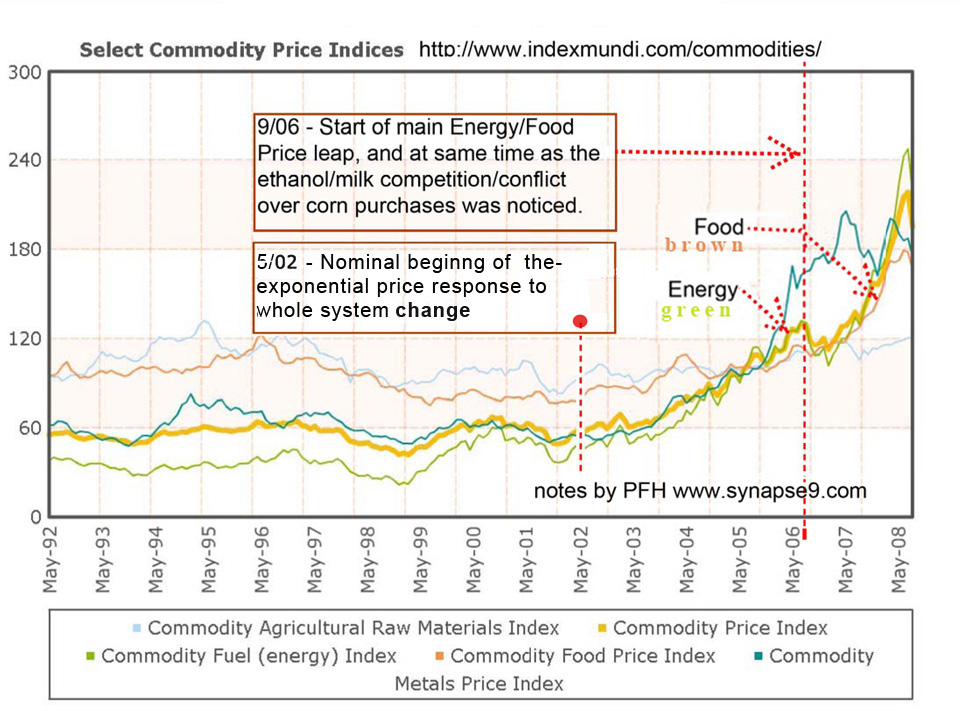The published article that followed from this is A decisive moment for Investing in Sustainability, published in New European Economy in Apr 2011. Back when I saw this particular event emerging I told people “We’ll definitely notice this one”. There’s much more to come people still don’t expect at all.
_________
John, your new post on the food crisis, “As Goes Egypt”, is great. To me how to connect economic theory with the natural world starts with learning how to read the behaviors of the system as a whole, looking for things no one has any theory for.

That includes strains that are not supposed to be there, like hitting the hard global limits of affordable food, fuel and water, etc. My research method basically rests on emerging growth systems being invariably unstudied, because growth indicates nature doing something new.
Growth is evidence of an emergent system for which no one could have any theory
… since it never existed before. In it’s early stages it’s not yet mature enough for anyone to be able to tell quite what it’ll do…! So any time you see a growth curve in the data you can reliably ask, “what the heck is that?”, and be fairly sure you’ll get no answer from anyone, and need to start pulling together the threads by yourself.
The food crisis, for example, is seen graphically in the data curve from John’s blog post (above). You can see that a regular price escalation, inconsistent with the past, began in ~2003-4, and was only interrupted by the 2007-8 speculative spike in food prices and financial system collapse.
Where we are today can be visualized as a simple extension of that original growth curve, but with a second speculative spike occurring now. So for 7 years food prices have been following a “law of unlimited price” instead of the previously normal pattern of “supply and demand”.
Part of why I interpret it that way is that I noticed it in the spring of 2007 as a great speculation opportunity, at exactly the same time as the rest of the world’s speculators apparently did. The 2004-7 period of regular price escalation was out of character, evidence of supply consistently failing to meet demand. It was also visible in a range of other commodity prices at the same time too.
That was apparently what signaled speculators they could drive prices through the roof. I think it had a lot to do with toppling an increasingly fragile financial system. When you see a smooth growth curve it’s almost never a statistical artifact, but a “break from the past” of some kind.
What I noticed in early 2007 was the news of the grain market shock from big ethanol buys of Illinois corn. To me that news marked the direct collision of the global resource markets for food and fuel, and a signal of the earth running out of room to grow.
I said at the time that price event would be looked back as the start of “the big crunch” and no one would fail to notice the consequences quickly developing. I guess four years sort of confirms that.
So I think we should think of the main cause of the financial collapse as resource costs of most kinds rising systemically. As that never happened before, like a so called “black swan”, it would naturally upset predictions for the world as a whole if not noticed.
As a single phenomenon it wouldn’t be a “speed bump” or mistakes to be corrected by “greedy people doing bad things”. It would be more like “hitting a sand bar”, with increasing resistance to movement the harder you push.
If you think of it as the whole ship of humanity being stuck on a sandbar, well, you’re stuck. If you rev up the engines to try to push through it… that just wastes fuel and creates a fire hazard. So, in general the ideal would be to cool it down, make the speculators give up much of their somewhat ill-gotten gains, used to relieve debt and fund our adaptation to sustainability.
The “bigger” social crisis (if that’s possible) we’ll be dealing with for the next 100 years is learning what growth limits mean. At the limits of growth prices stop being regulated by the costs of production, and start being regulated as the price of survival.
With or without speculators, prices in a zero sum game go as high as it takes to squeeze enough people out of the market. It pits the more productive economic sectors and the rich against the less productive economic sectors and the poor, in a life and death struggle. That’ll definitely take some of the fun out of the endless growth idea, consuming ever more and concentrating wealth ever further, and more than enough to have to think about!
I collected some other research notes in responding to Ellen Brown on the subject (attached) if you’re interested in following this reasoning a bit further. That modern economics somehow failed to notice it coming… is of course part of the real crisis, and why we’re so completely unprepared for it.
The other sciences are equally unprepared for a world that has unexpected behaviors, too however, as are most of the social networks as well. So,… I guess that gives anyone the title of “leading authority” on it … just for speaking up! ![]()
Phil
__________
My letter to Ellen in response to her blog post “Egyptian tinder box“. My comment pointed out why speculators can’t drive up prices unless *something* corners the market…!
Ellen,
You’re quite right to point to speculative investment as central to the problem, but missing why speculation would have such a big effect now and generally didn’t before. For years and years increasing supply used to keep commodity prices stable, before 2003. Speculation can’t work unless *something* corners the market, creating a true scarcity relative to critical levels of demand. That this condition is emerging *again* so quickly after the similar five year long speculative price escalation from 2003-2008, is very telling about the real cause. The question, what is actually cornering the market?? ![]()

If you read the behavior of the system as a whole, taken as evidence of the resource supply the system as a whole is actually finding, the evidence points strongly to the world economy having hit a “snag” in 2003, a point of supply rigidity, some direct effective point of “peak everything”.
Below is a recent nice description. Other things are found with a search for it on my site. Richard Heinberg misses important things, but has written more on the dilemma than I, like his new Preface to Peak Everything. I think you make the quite common error of stopping with blaming the mischief of “bad people”. In this case that hides the misunderstood natural phenomena, that would necessarily be responded to incorrectly whether the “bad people” were up to mischief or not.
Phil
__________
My comment in reply to Patrick Adam’s pointing to the price shocks for resources that Richard Heinberg predicted, with my view adding a good statement of why a global economy might run into serious cost limits for all resource at once, and start shedding less productive sectors.
Patrick,
I strongly agree, we fibbed to ourselves for centuries, actually, that more plentiful and cheaper resources would always be forthcoming. Decision makers just wanted to make money, and so needed to quiet the complaints from people pointing to the clear evidence that the historic trend was reversing.
The best evidence that it’s happening to me is that we fibbed to ourselves so well, we don’t even recognize the most glaring symptoms. The six years of sharp price escalation in our interconnected food and energy resource costs, did not produce a response of increasing supply to lower the prices. It took a world financial collapse and whole sectors of the world economy being knocked out to lower demand and reduce prices somewhat.
It’s not just “peak oil” having occurred in that period in terms of cheap oil, and the declining EROI for energy caused by both increasingly costly risks of new supply needing costly regulation and use of naturally less productive resources. It’s also the range of other systemic constraints.
The list includes peak irrigated land having occurred ten years ago, the new direct competition between food and fuel for the same resources to drive a growth economy, the growing population and demand from China and India, and lots of other things. The whole network of constraints is closing in indicating that the global search for way’s out in running out of options. That all tells speculators to jump in on the upside of any price swing, seeing that the demand won’t be met, etc.
I wish is was easier to describe systemic behavior. My methods seem to be much better than what most people use, but then again, It’s hard for me to share them because of some of the conceptual leaps, like, why one would use ¸¸.•´ ¯ `•.¸¸ to help organize your thinking about how energy using systems behave as a whole.
When I wrote about it for the Oil Drum I found a Brookings paper that did a nice job of describing the unexpected lag in oil production behind it. You can find what I’ve written on it with a search for it on my site.
Systemic limits affect the whole system at once. That happens because “liquid” markets link all interchangeable commodities so they can relieve each other’s shortages and surpluses.
Systemic limits occur when all interconnected resources use up their spare capacity at once, indicating the shortage is not local, but in global search process as a whole. That this apparent “peak everything” behavior seems to have come back so quickly as the world economy started recovering indicates it never went away, reinforcing the initial appearance. I think it was the principle cause of the collapse, and only circumstantial that the biggest wave of failed financial expectations was in real estate.
In a nut shell? I think it means that we didn’t “hit an iceberg” and are now repaired and ready to steam ahead again, but that we hit a sandbar, and people are revving the engines trying to move it… and just not thinking straight in the least about what we should do.
Phil
